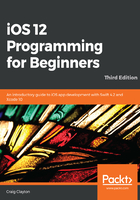
上QQ阅读APP看书,第一时间看更新
Checking the number of items in a dictionary
In addition to keys and values, we have other useful properties. We can see the number of items in a dictionary using the count property. Let's try that by adding the following:
print("There are \(dictPizzas.count) total pizzas.")
Now, your code and output should look like this:

Along with a count, we can check whether a dictionary is empty. Let's use this in an if...else statement by adding the following:
if dictPizzas.isEmpty {
print("there are no pizzas")
}
else {
print("There are \(dictPizzas.count) total pizzas.")
}
Now, your code and output should look like this:

This kind of logic is helpful when you want to display something back to the user or hide a UI.